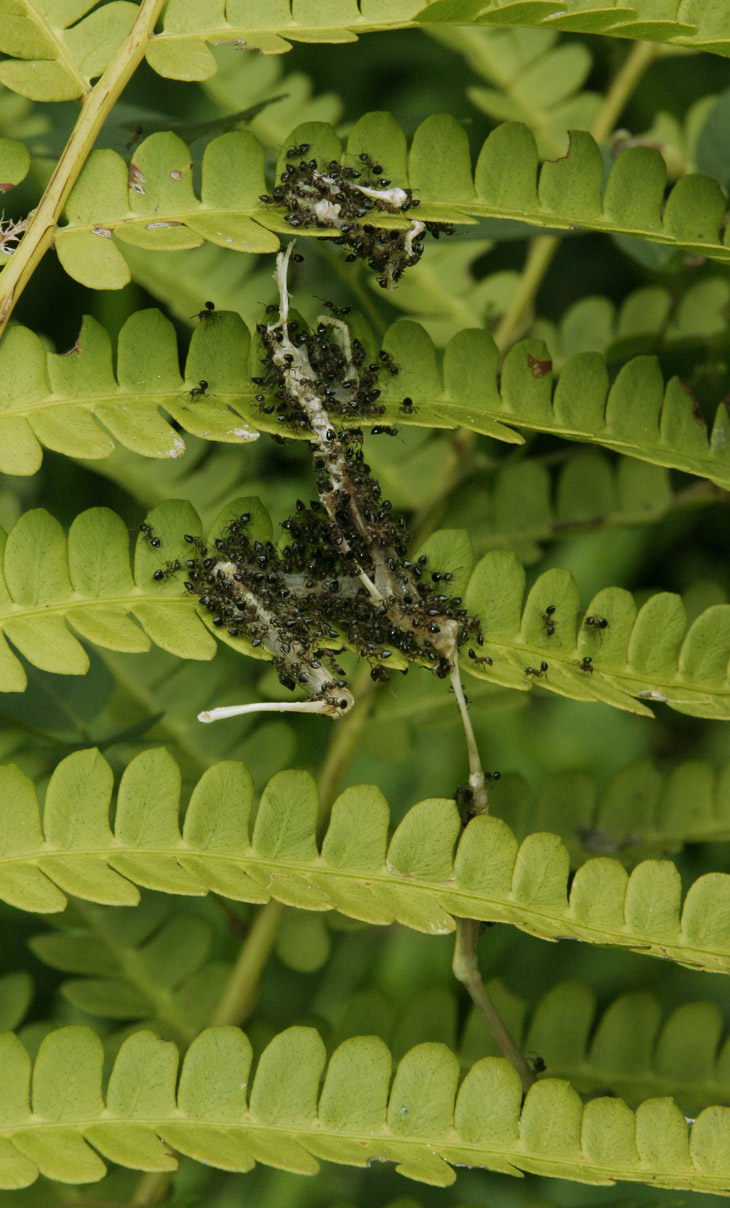So, the image I am about to show you can be considered creepy by a lot of people, I suspect largely through social conditioning, but whatever the reason, I’m suggesting you get over it; the amount of information and fascination that can result is a lot more interesting and useful than shuddering and saying, “Ewwwww!” And it’s not all that bad anyway.
Several years back in the NC Botanical Garden, I spotted a curious spectacle supported high on the leaves of a local fern. This was in a protected area well off the boardwalk, and there was only so close I could get to it, and just one angle to work from, so this is all I have. It’s a nice illustration of natural processes, but possessed its own mystery.

As a moment’s examination will show, this is a cluster of ants cleaning the carcass of some small deceased animal, with just enough anatomical detail showing through in the remains. The forebody had since dropped to the ground or leaves below, and the few remaining bones up there were too scattered and obscured to provide any details. The whole frame isn’t more than 15 cm in length, so this is quite small. It was taken in August, so this doesn’t narrow down the choice of species too much – virtually everything is active in August.
I’m not a biologist, and my knowledge of the various species around here doesn’t extend to their skeletal structure very well, but I nonetheless hazarded a guess, for years, as to what the departed was. The pelvic girdle is what I was going on for my guesses, knowing that most birds would have a broader pelvis, and that long narrow structure seemed to tell me it belonged to a long narrow critter; I considered this very likely to be a green anole (Anolis carolinensis,) something that I’ve seen countless times within the garden. Any further bits that could be used for confirmation, such as the skull, feet, or tail, had all dropped away under the ministrations of the ants, but it seemed like the safest bet to me.
Until I got ready to post this photo, sitting in my blog folder waiting for the winter slow season, and I started trying to find illustrations of anole skeletons. I quickly discovered that my thoughts on the pelvis were wrong: anoles have very minimal pelvises, certainly not the elongated type seen in my photo. Scratch that idea.
The way the hind limbs were splayed brought another species to mind, and a search for that skeleton came a whole lot closer to the mark. Tree frogs (second specimen shown on that page, scroll down a little) have pelvic girdles of exactly that nature, which makes a kind of sense: it serves as the anchor for the strong hindleg muscles that propel their leaps. In my mind, it should have been wider since frogs are broader-bodied than anoles, but they’re really not – they just sit bunched up most of the time, yet when stretched out they’re pretty slim.
[By the way, one of these days I’m going to try out those oxidizing techniques shown on that page, because I’ve always wanted a preserved skeleton of something. We’ll just have to see what I find dead but intact.]
Which species of treefrog isn’t something that can be answered, I think, from the minimal remains – we have both green (Hyla cinerea) and Copes grey (Hyla chrysoscelis) treefrogs around here, and their body structures are very similar. And how the frog died in that position and didn’t fall from the swaying leaves – that’s another question, one I’m not even going to try tackling. It seems like the ants made quick work of it though, since I doubt it would have remained long there given any rains or stiff breezes. Just one of those curious finds, right place, right time.



















































